Crumbling Rangoon Debates a New Look
By Stephen Brookes in Rangoon, Burma for Asia Times
__________________________________________________________________________________
About a mile into town from the airport, Yangon's quiet, tree-lined Pyay Road suddenly shifts into full-scale urban sprawl. Traffic backs up at Eight Mile Junction in a throat-closing haze of pollution, and a ramshackle jumble of half-built towers blots out the sky. And there, stretched out proudly above the chaos, is a billboard depicting the future: a shining city of steel-and-glass skyscrapers spreading to the horizon.
"It's a horrifying vision," said one Yangon resident. "We definitely don't want to become like that -- it would be Bangkok!" 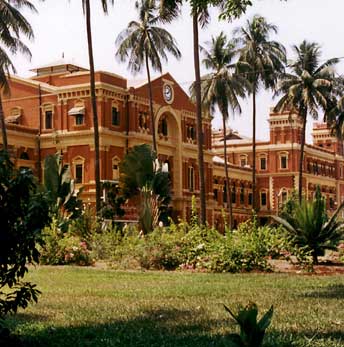
The crumbling Secretariat, in YangonBut Yangon's long isolation from the world is ending, and with it the placid pace of life that has marked most of the last three decades. As the country moves toward a market economy, Yangon (formerly known as Rangoon) is undergoing a rapid but helter-skelter renewal as old colonial-era buildings are torn down and modern new office and housing complexes sprout up in their place.
To many observers, the city has reached a critical turning point. If it wants to keep its distinctive character, it must find ways to modernize without destroying the past -- and time is running out.
The stakes, say architects and historians, are huge. "This city was once the gem of the region, and it could be the most beautiful and most liveable city in Southeast Asia," said Alfred Birnbaum, a researcher with the Institute of Asian Architecture at the University of Tokyo, during a recent visit to Yangon.
"It's a golden opportunity simply because nothing had been done for so long," he said. "So if planning is done in a very rational, controlled manner, you could attract an amazing number of businesses, tourists and residents. It could become a hub city for the entire region."
Long-term thinking is, theoretically, underway, as the Yangon City Development Committee (YCDC) develops a "master plan" which officials say should be ready in about a year. The plan is designed to cope with Yangon's rapid population growth and upgrade its outdated infrastructure, while avoiding the mistakes other cities have made in recent decades: overcrowding, pollution, chaotic growth and paralyzing traffic jams.
"We're trying to merge traditional civilization with modern thinking," said Lt. Cmdr. Tin Maung Myint, the chairman of YCDC's foreign relations and investment committee. "We've passed through many eras, and these have to be considered in our modernization. And we also want to make Yangon into a 'Garden City'".
The attempts to move simultaneously modernize and preserve began only recently. According to some experts, the process got off to a rocky start.
"In 1994, the order went out that the 'shameful colonial eyesores' had to be cleaned up," said one long-term Yangon resident. "The owners were typically given only about a month, and since they had no money to repair them, people just chipped off the decaying facades and put on a new coat of paint. The city hadn't quite realized that the old buildings should be preserved, that tourists would come to see them."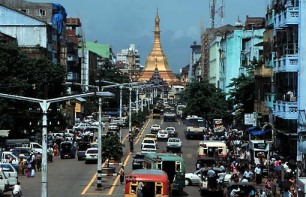
Downtown Yangon But by early this year, the YCDC changed course and moved quickly to label some 187 colonial and pre-colonial buildings as "heritage assets" that could not be altered or torn down. Most are in the downtown area, and range from the spectacular but abandoned-looking Secretariat -- the seat of the government -- to tiny historic houses and former schools.
Finding funding for the restoration, though, won't be easy. While the government is providing some funds, experts note that restoration is an expensive and laborious process that is often beyond the means of developing countries. As with Hanoi and other historic cities around the world, the international community can sometimes help. The Division of Cultural Heritage at UNESCO in Paris and the World Monument Fund in New York are two such groups.
But foreign advisors need to be sensitive to domestic concerns, caution experts. "International projects should involve a partnership by the aid country and the receiving country -- rather than foreign experts simply blowing in, summing up the situation without having had time to understand the local culture, and developing proposals which are out of line with local needs and aspirations", said Dr William Logan of Deakin University.
Other observers see a valuable source of funding in the private sector. "I really see corporate sponsorship as the hope for the short term," said the University of Tokyo's Birnbaum. "Corporations could locate offices in old buildings which have been restored. They could also sponsor a street or a neighborhood as a way of gaining face and exposure in the country and showing that they are making a positive contribution to the culture."
That's already started to happen in Yangon, where Texaco, Tiger Beer and a handful of other companies have restored decaying old buildings to their former splendor. One of the most elegant is a colonial villa on Inya Road that was completely restored last year by Diethelm Travel, and now serves as its Yangon office and living quarters for managing director Maren Dannhorn.
"We wanted an architecturally distinctive building," said Dannhorn, noting that when Diethelm head Luzi Matzig found the two-story house early last year, it was virtually a wreck. "When I got here in May," said Dannhorn, "we took the house to pieces -- only the walls, the windows, the doors and the woodwork were left. We gutted everything, and entirely replaced the electricity and plumbing -- even the roof. We worked on it day and night for three months".
The results are spectacular: the full flavor of the 1934 original has been kept, even down to the historically-accurate exposed wiring, while the building operates as a fully modern office, with computers on every desktop. Upstairs, the living quarters are spare but elegant, with a balcony overlooking the Shwedagon Pagoda. The cost of restoring a part of the city's heritage? A very reasonable US$55,000.
While applauding the efforts to restore specific buildings, some experts note that a more subtle and difficult task still remains: maintaining the overall distinctive character of the city.
"It's good to preserve famous buildings, but many buildings that aren't particularly noteworthy should be considered in the context of the urban integrity," said Birnbaum. "You have to think about not only individual buildings, but whole areas."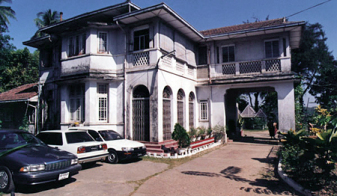
Aung San Suu Kyi's colonial-era villa in Yangon Stephen BrookesAnd key to that, say observers, is maintaining height limitations. "If you're going to create an image of a city, you don't want a piecemeal image -- you want an integral whole," said Birnbaum. "And height is probably the primary factor creating a unified image. One you start poking holes in the skyline, the unified image is gone. If you build like Bangkok, where there is no height limitation and no zoning laws, then you get a mishmash."
The YCDC's Tin Maung Myint agrees, noting that new buildings are restricted to 12 stories, and that all new construction has to be approved by the city. "We want to preserve the light of the city," he said. "We don't want to build a cement jungle."
Moreover, city officials said that the vast open areas in and around Yangon mean that there's no urgent need to tear down the city's architectural heritage. The city has been expanded to 232 square miles, with a number of new townships created in the outlying districts. "Previously, people were squeezing into Yangon," said Tin Maung Myint. "Now we're trying to get rid of the huts and give people better land in the satellite towns, where they can have their own houses and their own land."
That plan makes sense, said one foreign urban planning expert, and may help to alleviate Yangon's growing traffic congestion, as well -- as long as plans are made to improve public transportation. By relieving population pressure on the downtown area, the new townships also help reduce pollution, as well.
One key issue, in fact, is the development of industrial zones outside the city, in order to remove polluting factors as far as possible from residential areas. In one part of the downtown area, for instance, commercial printers dump highly toxic chemicals into open drains, creating a potentially lethal health hazard.
"We can modernize without tearing down the old city, because we have a lot of open land," said Tin Mung Myint.
There's also a great potential for improving city's physical beauty by removing the container warehouses along the river, say urban planners. A magnificent row of colonial-era buildings runs along along the north side of Strand Road, including the red brick Custom House, the pastel-green Myanma Port Authority, the ornate Myanmar Economic Bank, the stolid police headquarters with its three-story columns and, of course, the famous Strand Hotel. 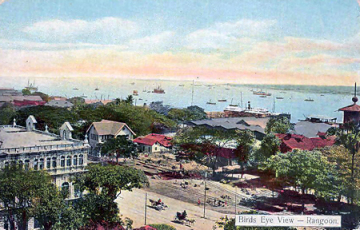
Rangoon in the late 19th CenturyBut the their beauty is marred by an imposing brick wall of warehouses that completely blocks the city off from Yangon River and the view of Dalat on the opposite shore.
"I would move the port elsewhere and build a Bund, a walkway along the harbor -- it would be magnificent, and one of the most important things they could do," said one urban planner in Yangon. "The port facilities are not that big, so if they are going to do it, now would be the time. And the city is much bigger now than it was when the port was built -- there's no need to have cargo dropped immediately into the city."
City planners say they do plan to move all the container yards up the river to a new deep-water port being constructed at Thilawa, but there are no plans yet to replace Yangon port with a park.
Opening up the southern edge of the city may become more urgent as more skyscrapers go up in the city center. Despite the ordinance limiting buildings to 12 stories, the city's skyline has been abruptly broken in the past year by several new hotels, including the Trader's Hotel and the Sofitel Hotel on either side of the landmark Sule Pagoda in the heart of town. Both run upwards of twenty stories, and the Sofitel casts an unfortunate afternoon shadow over the previously sunny park in front of the elegant old Supreme Court.
Moreover, most of the new buildings going up in Yangon are architecturally undistinguished. One of the exceptions is the new Kandawgyi Palace Hotel, which architects cite as a good example of what the city should be striving for. "Unlike the Sedona Hotel, the Kandawgyi fits into its lakeside site beautifully -- it actually improves the view of Royal Lake," said one.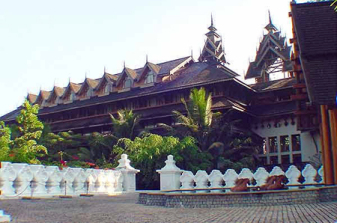
Kandawgyi Palace HotelBut much of the newer construction tends to be impersonal, say some critics. "They want military corners on everything," said one planner. "Take the new National Museum -- on one level, they are talking about preserving Myanmar tradition, but what is Myanmar about this building? There's nothing particularly distinctive about this building. It could be anywhere."
Others note that there's a great opportunity now for the development of a distinctively Myanmar school of modern architecture, avoiding glazed glass buildings which reflect heat and consume huge amounts of energy.
"Around the world, wooden consumption in private houses is almost a thing of the past," noted Birnbaum. "But here, you've got the wood -- and Myanmar could take the lead in combining the best of modern ferro-concrete construction with wood construction. Myanmar has a proud tradition of building with teak. It could really provide a shining example of how wood construction has a future.
"It would be good for the city to make a few prime examples of what can be done, so that people can see it and say, this is a joy to look at, and also clean and safe and efficient", he added. "And at the same time you could bring in very traditional Myanmar elements which would be distinctive and say: 'We are not like Bangkok. We are not going to become the hell of Southeast Asia'."
(Asia Times, 1997)
References (3)
-
 Response: Нефть РоссииДом Окна
Response: Нефть РоссииДом Окна -
 Response: Interior Design consultants in Dubai
Response: Interior Design consultants in Dubai -
 Response: Hvac Companies Sicklerville
Response: Hvac Companies Sicklerville


Reader Comments (4)
i am an architect (-and have studied history of architecture with a focus to colonial architecture and have long year experience of the far east and SE-asia -) if there is an initiative/campaign of doing s.th.for the architectural gem of rangoon - please let me know: i would be glad to stay at your side!
with my best regards! martin beilmann.